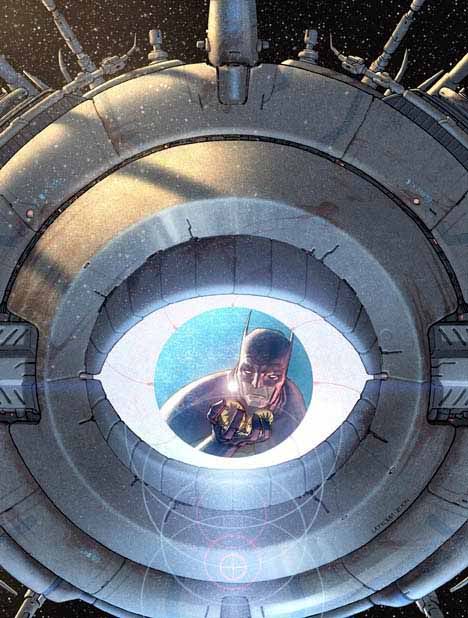Volume 1, Entry 2
The O.M.A.C. Project
Greg Rucka - Writer
Jesus Saiz - Pencils
After Countdown to Infinite Crisis, DC launched the four mini-series that would lead us dear readers into the comic event nearly 20 years in the making. A cynic would say that DC decided to release four consecutive six-issue mini-series before the main event merely to sell more books and tie-ins. And those cynics would be right. When I first read The O.M.A.C. Project nearly seven years ago, it was a lot more impressive. Perhaps it was the anticipation of greater things to come.
 Greg Rucka pens a story better suited for an oversized one-shot (or at most, a three-issue series) more than an extended six-issue saga. Much of the page space is taken up with needless exposition and somewhat pointless espionage panels. And even with all the talking and cold stares, Maxwell Lord - the title's titular villain - is barely fleshed out as a character. The O.M.A.C. Project tells the tale of how Max Lord hijacked Batman's paranoia-inspired Brother Eye - a satellite equipped with any and all information pertaining to all meta-humans across the planet. Lord's motive is solid - he's frightened of the sheer power heroes like Superman wield - Lord has a history in the DC universe, yet Rucka takes little time to give the reader context as to why Checkmate's Black King is so damn mad at superheroes.
Greg Rucka pens a story better suited for an oversized one-shot (or at most, a three-issue series) more than an extended six-issue saga. Much of the page space is taken up with needless exposition and somewhat pointless espionage panels. And even with all the talking and cold stares, Maxwell Lord - the title's titular villain - is barely fleshed out as a character. The O.M.A.C. Project tells the tale of how Max Lord hijacked Batman's paranoia-inspired Brother Eye - a satellite equipped with any and all information pertaining to all meta-humans across the planet. Lord's motive is solid - he's frightened of the sheer power heroes like Superman wield - Lord has a history in the DC universe, yet Rucka takes little time to give the reader context as to why Checkmate's Black King is so damn mad at superheroes.Sasha Bordeaux is also a pretty lame character. Of course she's a Rucka-created character because she has barely any development or personality. In O.M.A.C., she is simply the cardboard cutout that acts as the 'main character', the one us readers are forced to follow around despite her inane dialogue. And Jesus Saiz's 'same face' syndrome is quite problematic in these pages, as Bordeaux looks nearly the same as her sort-of-rival Jessica Midnight, another Checkmate agent, one who opposes Lord's total control of the organization.
***SPOILERS***
And then there's "Sacrifice", an arc within an arc leading up to the beginning of O.M.A.C. #4. What's unfortunate is that in an obvious ploy to sell more books, DC made reading "Sacrifice" a necessity to understand anything in O.M.A.C.'s plot going forward. In September of 2005, readers had to pick up Superman #219, Action Comics #829, Adventures of Superman #642, and Wonder Woman #219 to get the whole story of how Max Lord uses his mind control abilities to make Superman his own meta-human weapon. At the end of Wonder Woman #219, Diana snaps Max's neck while Brother Eye records everything. And that is exactly where O.M.A.C. #4 picks up! Even when it was current, I remember feeling taken advantage of by DC; why shouldn't all the major plot points of a mini-series exist within said series? It's such a point of frustration that really had no purpose. Later on (around issue 5) the Brother Eye gains sentience, which is pretty cool, but even that juicy plot development gets sidetracked so we can get back to Sasha's personal drama. Bleh.
So, the basic problem with O.M.A.C. is a lack of depth. The idea for the story is a solid one rooted in DC's tumultuous past, but the concept and plot are given very little room to grow and are thus bogged down by their own weight. Definitely read The O.M.A.C. Project, if only for the basic necessary facts needed going forward into Infinite Crisis. Beyond basic exposition, there is little else to love about this title.
Grade: C-
No comments:
Post a Comment